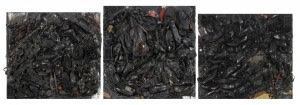 |
| Cindy Sherman, Untitled (#547), 2010-12 |
 |
| Cindy Sherman, Untitled (#548), 2010-12 |
Indeed, the recent photographs on display
at Gagosian’s Paris gallery are a long way from the film stills. In this
current series of untitled images, Sherman the actress and star of her own
photographs is seen posing in Romantic landscapes. She wears outfits courtesy
of the Chanel archives, garments that are rich and luxurious in their fabric,
ornamentation and form. The discontinuity between the exaggerations of the figure
and the depthless landscapes is contrived for maximum collision and
incompatibility. The landscapes gesture towards being dreamy, towards an
invitation to fall into them. However, they are cold — in color, temperature,
and thanks to a digital manipulation process that makes for a harshness. And so,
I at least was never tempted into contemplation of the landscapes. On the
contrary, Sherman’s figure is so arresting — through its composition,
performance, detail — that it is easy to walk around the exhibition taking no
notice of the brown, grey and other tonally depressing landscapes. Thus, Sherman reverses
the diminished figure in an overwhelming and animated landscape that is the
preoccupation of Romantic painting. Similarly, the separation and collision of
foreground and background, figure and landscape cracks open the seduction to
contemplation that is so typical of Romanticism.
 |
| Cindy Sherman, Untitled (#540), 2010-12 |
Sherman’s critics and commentators are
always quick to point out the political importance of her work, an importance
that still makes sense within wider discursive contexts on identity. The manipulation
and undoing of Romantic yearning is surely the site of these photographic
statements about the self, identity, and particularly, women’s social and
cultural identity in these images. The foregrounding of the artist as performing self in a
landscape to which she has no relevance, a landscape from which she is completely
alienated, could logically be interpreted as the photographs’ raison d’être. Because the outfits are
inappropriate, to the point of irony, the regard and hand articulations are
exaggerated and cold, the foreground-background relations are disproportionate,
and so on, the image arrests us, it prevents us from falling into the
photograph. We are thus commanded to confront the emptiness of this reality,
its drain of emotion, its absurdity even.
While I understand the importance of these
claims in Sherman’s photography, I still can’t help thinking that through the
engagement with Romanticism, the urgent politics that were so provocative in
the Untitled Film Stills are now lost.
The early work, and particularly, the Untitled
Film Stills were instrumental in the ignition of a discourse on the
representation of woman, and the imperative to arrest the ogling of a viewer
that had been identified as the most oppressive strategy of Hollywood film. However,
I am not convinced that this later work is intervening in public discourse to
the same extent. It is true that, rather than having a male wanderer in a
powerful overwhelming landscape, Sherman places a lone woman in a landscape
that is on the precipice of disappearance, thereby screaming the
imperative to stand up and take notice. However, because the reference of the recent photographs is a
Romantic aesthetic, it doesn’t have the currency or the urgency of intervention that was so ground breaking in the earlier works critique of the popular cultural landscape of Hollywood film.
 |
| Cindy Sherman, Untitled (#552), 2012 |
All Images Courtesy of Gagosian, 2012

Paper.jpg)










